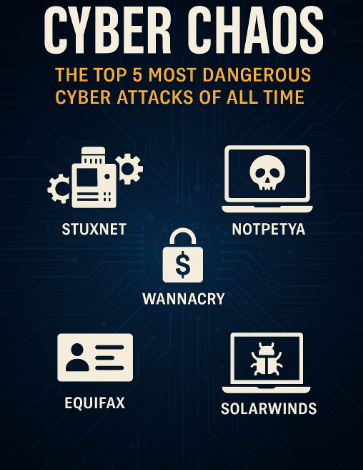

In the age of digital interconnectedness, cyberattacks have evolved from minor digital pranks into highly sophisticated operations capable of crippling governments, corporations, and entire infrastructures. Over the past few decades, the world has witnessed cyber assaults that not only stole data but shook global security, triggered political tensions, and inflicted billions in damages. Here’s a look at the top five most dangerous cyberattacks of all time—incidents that redefined the scale and impact of cyber warfare.
1. Stuxnet (2010): The World’s First Cyber Weapon
In 2010, the discovery of a highly sophisticated computer worm named Stuxnet marked a turning point in cyber warfare. Unlike previous attacks focused on data theft, Stuxnet was designed to cause physical destruction. Believed to be a joint operation by the U.S. and Israeli governments, it targeted Iran’s nuclear facilities—specifically, the centrifuges at the Natanz uranium enrichment site.
Stuxnet was capable of infiltrating air-gapped systems via infected USB drives. It subtly sabotaged centrifuge speeds while feeding false data to monitoring systems, delaying Iran’s nuclear development without a single missile fired.
2. WannaCry Ransomware (2017): Global Disruption in Hours
In May 2017, a massive ransomware attack called WannaCry infected over 200,000 computers in more than 150 countries within hours. The malware encrypted users’ files, demanding Bitcoin payments in exchange for decryption keys.
It disrupted UK hospitals, global logistics, telecom networks, and major corporations. WannaCry exploited a Windows vulnerability originally discovered by the NSA, then leaked by a group called the Shadow Brokers.
3. NotPetya (2017): Economic Sabotage Disguised as Ransomware
Just a month after WannaCry, NotPetya emerged. Disguised as ransomware, it was actually a data-wiping malware. It started in Ukraine by compromising accounting software and spread globally, crippling operations at Maersk, Merck, and other multinational companies.
Maersk, for instance, had to reinstall 45,000 PCs and 4,000 servers, suffering estimated losses of $300 million.
4. Equifax Data Breach (2017): Identity Theft at Massive Scale
In 2017, Equifax, one of the largest credit reporting agencies, suffered a breach exposing the personal data of 147 million Americans—including names, Social Security numbers, and addresses.
Hackers exploited an Apache Struts vulnerability, and the breach went undetected for months. The U.S. government later attributed the attack to Chinese military hackers.
5. SolarWinds Hack (2020): Espionage at the Highest Levels
In late 2020, the world learned of a massive supply chain attack involving the IT firm SolarWinds. Hackers inserted malicious code into an update for the Orion software platform, used by thousands of organizations.
Among those affected were U.S. federal agencies, Microsoft, and several Fortune 500 companies. The malware gave attackers prolonged access to internal systems for months.
Conclusion
These cyberattacks are more than cautionary tales—they mark milestones in the evolution of cyber warfare. From physical sabotage to mass surveillance and identity theft, these incidents show the increasingly complex and dangerous nature of cyber threats. With growing reliance on digital systems, governments and organizations must invest in robust cybersecurity defenses, international cooperation, and public awareness to protect against the next big digital onslaught.
📌 Reference: Zetter, K. (2014). Countdown to Zero Day: Stuxnet and the Launch of the World’s First Digital Weapon. Crown Publishing
📌 Reference: Greenberg, A. (2018). “The Untold Story of NotPetya, the Most Devastating Cyberattack in History.” Wired Magazine.
📌 Reference: Greenberg, A. (2018). “The Untold Story of NotPetya.” Wired.
📌 Reference: U.S. Department of Justice (2020). “Four Chinese Military Hackers Charged in Equifax Breach.”
📌 Reference: The New York Times (2020). “As Understanding of Russian Hacking Grows, So Does Alarm.”




